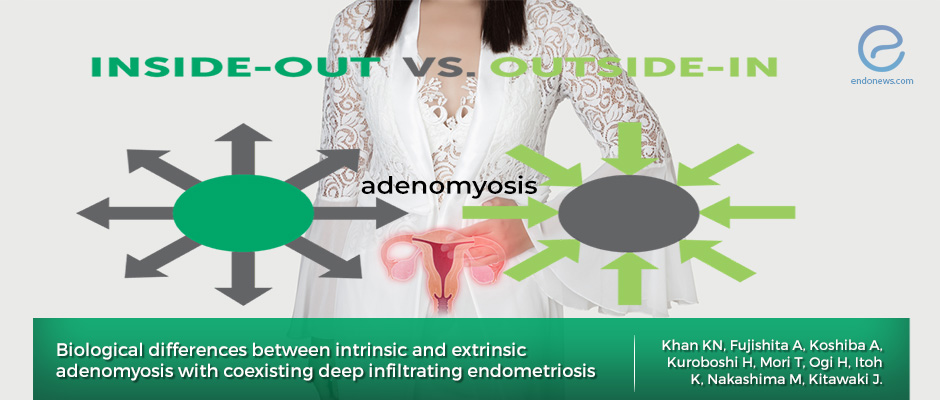Inside to outside or from outside to inside?
Aug 9, 2019
Histopathologic findings reveal similarities between deep infiltrating endometriosis and a subset of adenomyosis, “adenomyosis externa”
Key Points
Highlight
- Adenomyosis, ectopic endometrium tissue within the uterine muscles, is an estrogen-dependent disease, and the pathogenetic mechanisms have not been well explained yet.
- Invasion of myometrium from basal endometrium is a generally accepted view.
- Based on histopathological findings of immunohistochemical markers, adenomyosis involving outer myometrium reveals clues for an origin coming from outside of the uterus, like deep infiltrating endometriosis.
Background:
- Though adenomyosis seems to be the invasion of myometrium from the basal endometrium, a considerable number of cases appears to be the result of an invasion of endometrium-like structures from outside the uterus via disrupting the uterine serosa.
- This new concept in pathogenesis could be proposed whilst dividing adenomyosis into two subgroups precisely.
- This conceptual view regards adenomyosis involving inner-mid myometrium as being formed by direct basal endometrial invasion adenomyosis; in the outer myometrium as a component of deep infiltrating endometriosis, hence “adenomyosis externa”.
Key points:
- As the pathogenetic mechanisms of adenomyosis are not clear only with a postulated origin from basal endometrium new research topics emerged revealing similarities with deep infiltrating endometriosis in some cases.
- The concept regarding adenomyosis as being formed by direct basal endometrial invasion could apply for the cases involving inner-mid portion whereas as an endometriotic lesion involving the outer myometrium.
- This conceptual view has supportive findings immunohistochemically as well as fibrosis patterns, and by conventional histochemistry.
Lay Summary
Pathogenesis of "adenomyosis", presence of the ectopic endometrium tissue within the uterine muscles, has largely been classically based on origin from basalis endometrium.
Khan and associates from Japan have published their new conceptual findings on adenomyosis in Reproductive BioMedicine Online. In a considerable number of cases adenomyosis involving the outer myometrium may be linked to invasion of endometrium-like structures from outside disrupting the uterine serosa.
In this prospective controlled study, surgical specimens from 23 women with intrinsic adenomyosis (i.e., involving inner-mid myometrium) and 10 women with extrinsic adenomyosis (i.e., involving outer myometrium) with coexisting deeply infiltrating endometriosis lesions (DIE). A histopathological assessment was made by immunoreaction to Ber-EP4 (epithelial cell marker) and CD10 (stromal cell marker), estrogen and progesterone (ER/PR). Tissue fibrosis was assessed by Masson’s trichrome (MT) staining with computer-based image analysis of fibrosis in respective samples.
The rate of coexistent DIE was higher in women with extrinsic adenomyosis (9/10, 90.0%) than in women with intrinsic adenomyosis (3/23, 13.0%, p<0.001). The pattern of Ber-EP4-positive glands and CD10-positive stromal cells of extrinsic adenomyosis had a close relevance to DIE lesions. Besides, the pattern of the gland/stromal cells was similar to the endometrium in the cases with intrinsic adenomyosis. Unlike extrinsic adenomyosis, PR expression was significantly decreased in both glands cells (p<0.05) and stromal cells (p<0.05) of intrinsic adenomyosis. Image analysis of MT-stained fibrosis indicated that fibrosis was relatively stronger in the specimens of extrinsic adenomyosis and coexistent DIE than in intrinsic adenomyosis and their coexistent DIE.
Accordingly, adenomyosis involving inner-mid myometrium seems to be formed by direct basal endometrial invasion whereas adenomyosis in the outer myometrium as a component of deep infiltrating endometriosis, hence “adenomyosis externa”. These novel morphological findings with similarity to DIE in “adenomyosis externa” may yield a better understanding of the pathogenesis adenomyosis. This could also lead to better insight into the biology of disease with possible clinical impact.
Research Source: https://www.ncbi.nlm.nih.gov/pubmed/31160242
adenomyosis extrinsic adenomyosis adenomyosis externa fibrosis

